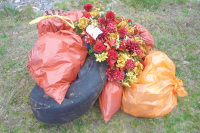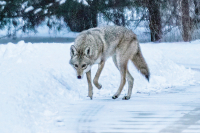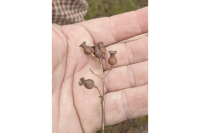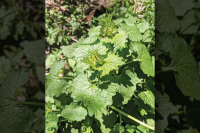Managing invasive species: Plant removal begins in Pinnacle Park
 Hannah McLeod photo
Hannah McLeod photo
After a botanical survey identified the location of several invasive species in Jackson County’s Pinnacle Park, work has begun to manage the ecologically threatening pests.
“We live in a very diverse botanical environment and the exotic species will and do change the nature of habitats,” said environmental scientist Jason York. “It’s important to make sure we’re protecting the species that have been here for 80 million years.”
Pinnacle Park comprises just under 1,800 acres of land situated near Sylva and is bordered by other conserved lands. In 2007, the Fisher Creek Tract, about 1,100 acres of the former town watershed, was placed under a conservation easement and opened to the public for recreation shortly thereafter.
The Blackrock Tract, about 435 acres abutting the original Pinnacle Park property on the crest of the Plott Balsam Mountains, had previously been slated for development before those plans were abandoned. In 2016, The Conservation Fund started looking for partners to help conserve the 912-acre property.
Mainspring Conservation Trust protected it under a conservation easement and Sylva acquired the 435-acre Blackrock Tract in 2019 after the Eastern Band of Cherokee Indians purchased the adjacent 471-acre Shut-In Creek Tract, completing the complex conservation deal.
On the other side of the main Pinnacle Park property is the Dills Creek Tract, also a failed development. Mainspring is currently working on getting this 246-acre piece of land into a conservation easement and transferring it to the town.
Related Items
In 2021, the Pinnacle Park Foundation released a request for proposals to conduct a botanical survey of the park prior to building any additional trails and amenities.
“The overarching message from Equinox to the town, to the foundation, is you have a gem,” said Owen Carson, plant ecologist for the Ashville based consulting, planning and design firm Equinox Environmental, in a presentation to Sylva’s town board following the survey. “You have a wonderful, amazing place with a lot of really special and important species, assemblages of natural communities, water resources and wildlife. And you have an opportunity at this point in time to take a positive step in the stewardship and management of Pinnacle Park.”
The results of the botanical survey showed Pinnacle Park contains at least 25 different natural community types, some of which are very specific to certain topographic or elevational areas. The park contains over 19 miles of streams and seeps with excellent water quality and bio classification ratings and several rare species of vascular plants.
A natural community is a distinct and recurring assemblage of populations of plants, animals, bacteria and fungi naturally associated with each other in their natural environment.
After conducting the botanical survey, Equinox consolidated some of its findings into recommendations for the Pinnacle Park Foundation. These included protection of sensitive elements, poaching prevention, restoration of degraded roads and trails and control of nonnative invasive species.
The botanical survey ranked invasive species according to their risk level and recommended taking immediate action on populations that pose a high risk to the area. For example, invasive kudzu, which is present on the lower end of the Pinnacle Park side and on the upper reaches of the Blackrock side of the park, is known to grow over native plants, pull down trees and does not hold soil back. The recommendation was to eradicate invasive species from the property.
“An overarching nonnative invasive plant management plan would be a good idea,” said Carson.
The town has started in on such a plan, hiring an independent contractor, Michael Baker International, to manage and remove the invasive species that had been located and documented by Equinox Environmental. Work on the project began last fall.
Invasive plant species located within Pinnacle Park include kudzu (pueraria montana), multiflora rose (rosa multiflora), oriental bittersweet (celastrus orbiculatus), privet (ligustrum vulgare) and Burning Bush (Euonymus alatus).
“A lot of invasive species have gotten here in a lot of different ways, but oftentimes they’ve gotten here because people have planted them,” said York, one of the scientists working on the invasive plant management and removal project.
“Other times they’ve gotten here because we thought they were useful for things like erosion control, wildlife forage or habitat, and they were actually intentionally planted in places. Only to find out, 30, 40, 50 years later, that that was a big mistake,” York said. “But they were planted by everyone from the Department of Transportation, Fish and Wildlife Service, some were even used for shipping like packing peanuts.”
Kudzu, sometimes known as “mile-a-minute” or “the vine that ate the South,” is a creeping, climbing perennial vine that can grow up to a foot per day during the summer, overtaking trees and other native species. Originally native to Japan and southeast China, it was first introduced to the United States during the Philadelphia Centennial Exposition in 1876 where it was touted as an ornamental plant with sweet-smelling blooms and sturdy vines.

Kudzu is an extremely invasive plant species in Southern Appalachia. File photo
From the 1930s through the 1950s, the Soil Conservation Service promoted it as a tool for soil erosion control and planted it throughout the south. Kudzu spreads through runners, stems that root at the tip when in contact with moist soil, rhizomes and by vines that root at the nodes to form new plants. Today kudzu covers an estimated 7 million acres across the Southeastern United States and is making its way into the Northeast, Midwest and as far west as Oregon.
Multiflora rose was also introduced to the United States from Japan. It arrived in 1866 as rootstock for grafted ornamental rose cultivars. It spread in the 1930s when it too was introduced by the Soil Conservation Service for use in erosion control and as living fences, or natural hedges, to confine livestock.
Oriental bittersweet, privet and burning bush are all ornamental plants that were also introduced from Asia to the United States during the 19th Century.
And while all of these species are exotic, not all exotic species are invasive. Likewise, not all invasive species are exotic.
“What we’re dealing with at Pinnacle Park are invasive exotic species, so they’re not native to the region, in most cases not even native to the continent and they create a problem by spreading so quickly and efficiently and taking over a natural ecosystem, displacing native species,” York said.
There are some native species that can be invasive. For example, poison ivy might cover a large area if not controlled.
“Invasive plants could be anything that just does a really good job of outcompeting its neighbors,” York said. “But we don’t typically treat invasive plants that are native. We typically only focus on non-native invasive species, which is to say invasive exotic.”
In order to eliminate or manage these invasive exotic plants carefully, environmental engineers use a system known as Integrated Pest Management (IPM).
“What that means is that you’re using a variety of methods to eliminate or manage it most effectively while doing the least damage to the natural environment,” said York.
For kudzu, this involves cutting vines and using an herbicide that’s approved for use near water.
“In a case like kudzu, there’s often not a lot of non-target damage to worry about because it grows in such dense patches,” York said.
After cutting vines and spraying, scientists will continue to go back in subsequent growing seasons to make sure they didn’t miss anything. They will retreat anything that grows back or has sprouted from seeds existing in the soil from the infestation being there.
According to York, dealing with invasive species is never a one and done scenario. Follow-up usually continues for about three years, during which time the areas where invasive plants were thriving continue to be monitored.
“People have to understand what invasive plant management is, that it’s not eradication. It’s management, it’s control,” York said. “What we’re trying to do is to preserve areas that have unique and pristine ecosystems, so they don’t get overtaken by these species, as opposed to trying to control them.”
In the case of plants like burning bush and multiflora rose, engineers will cut them very low to the ground, so there is about an inch of stem left above the ground. Then they apply a much more concentrated form of herbicide directly to the stump so that it’s absorbed into the root system without impacting any of the other plants around it.
From there, the team will monitor the site for another year or two.
“Inevitably you’ll have some of the root system start to come back up and when that happens, then you can retreat it,” said York.
While most people have a negative view of the use of herbicides, those that are being used in Pinnacle Park have low toxicity to humans, animals and the environment. Applicators are careful to minimize herbicide application to native vegetation, water and non-target surfaces and access to treated areas is restricted during and after herbicide application. Only those herbicides registered by the EPA for use in water are applied around creeks and wetlands.
For a place like Pinnacle Park, early detection of and rapid response is key to combatting invasive species.
“Let’s preserve these ecological islands, these areas that are important that contain healthy populations and seed sources of these wonderful native species that we have,” York said. “If you can find a place like Pinnacle Park that is just beautiful and relatively pristine, get it to a point where there’s not so much that we can’t take care of it. Let’s get it before it goes crazy, and it becomes a problem.”













